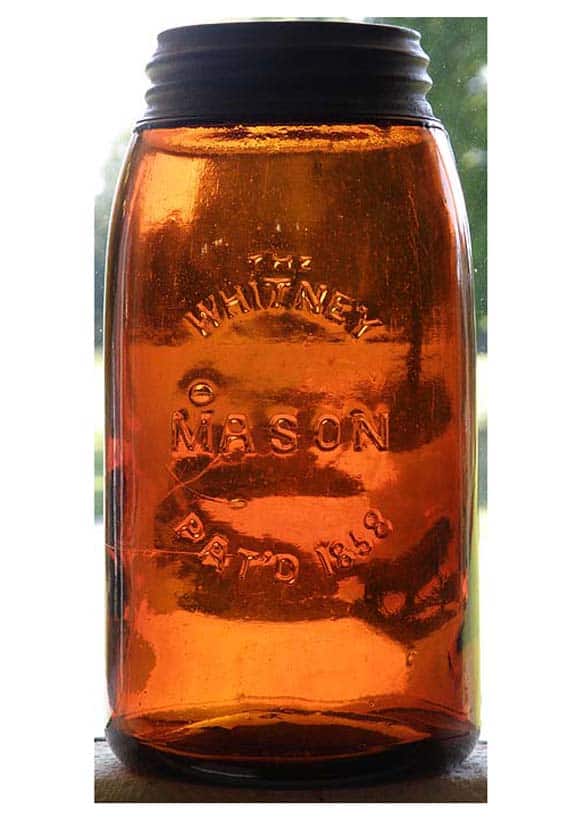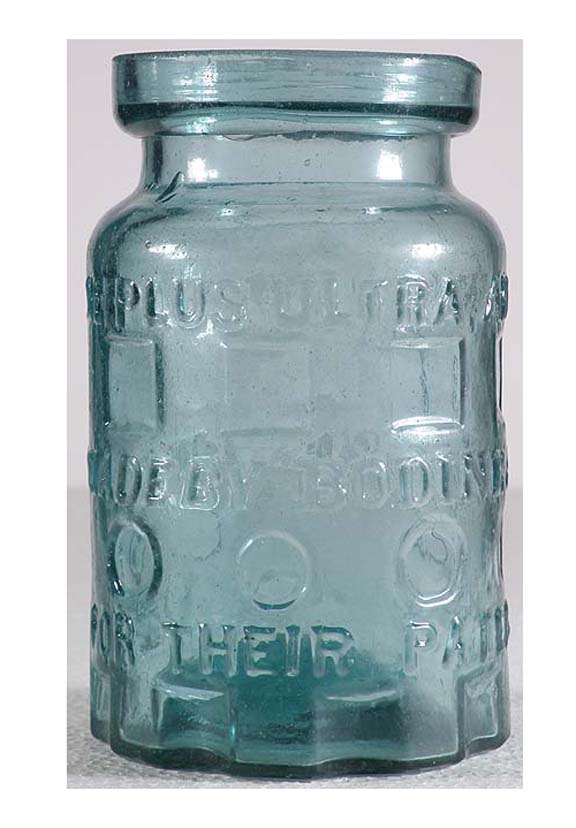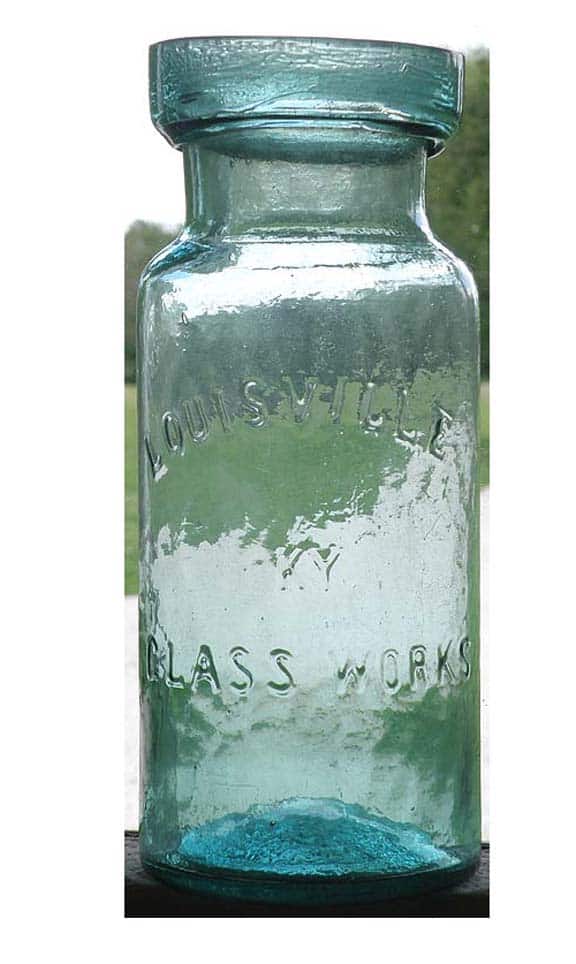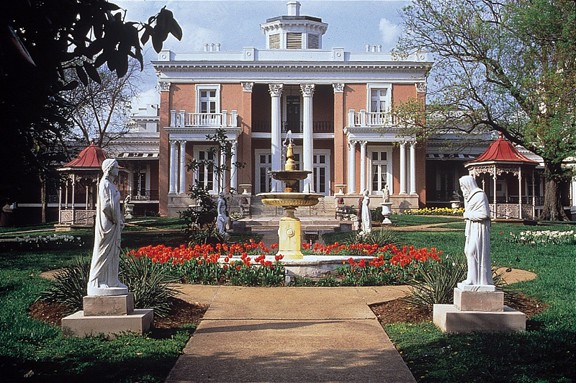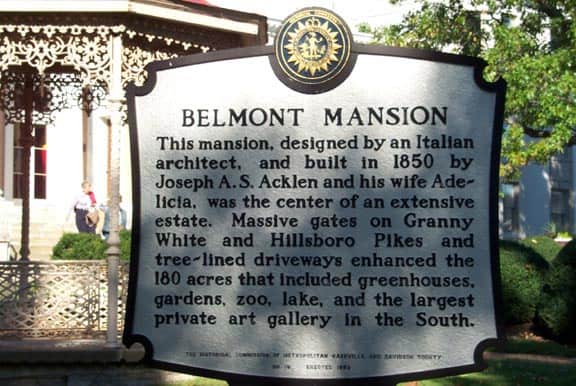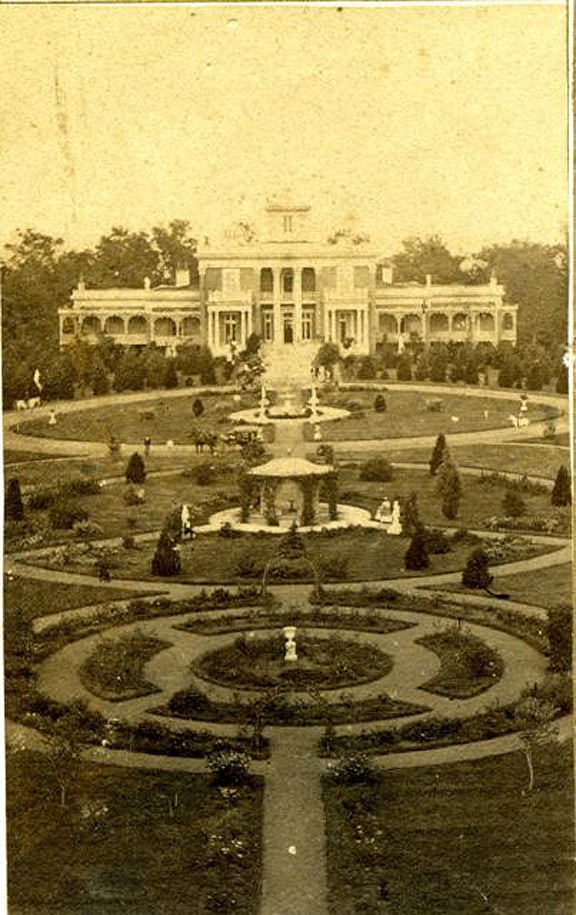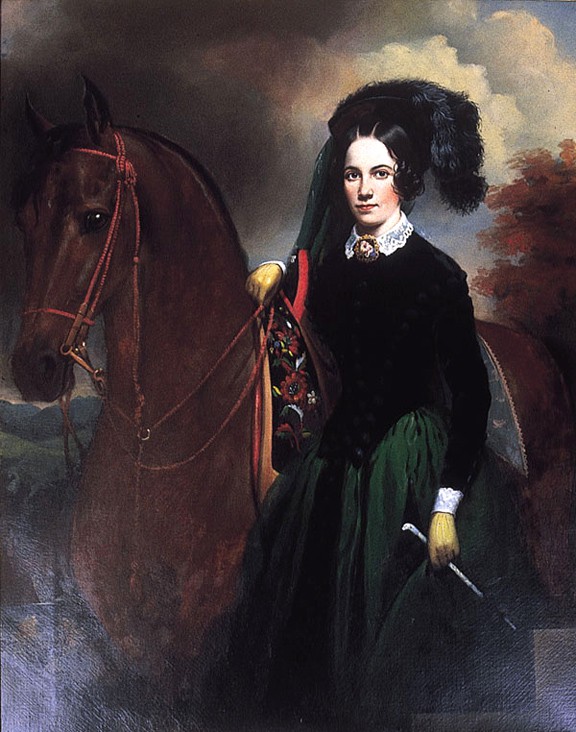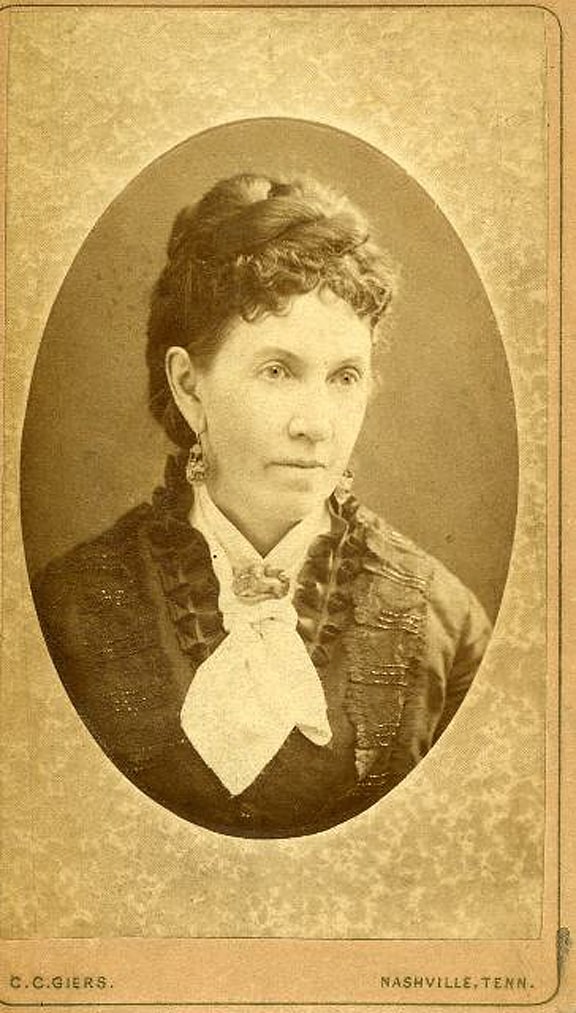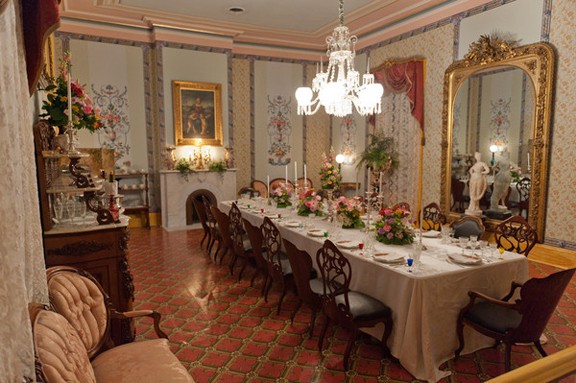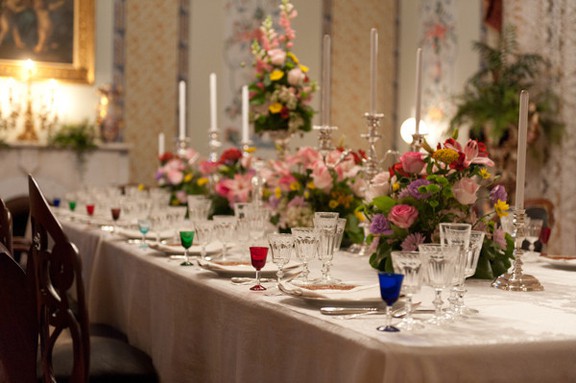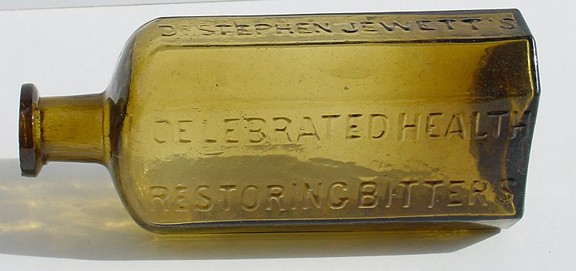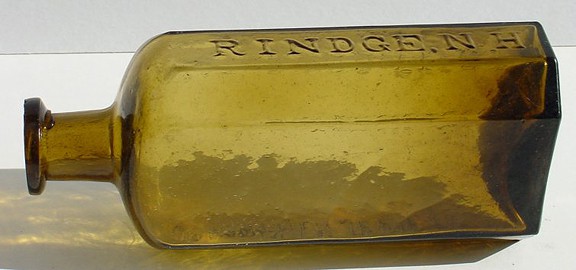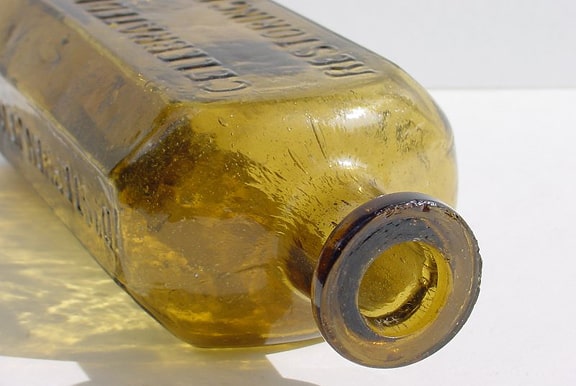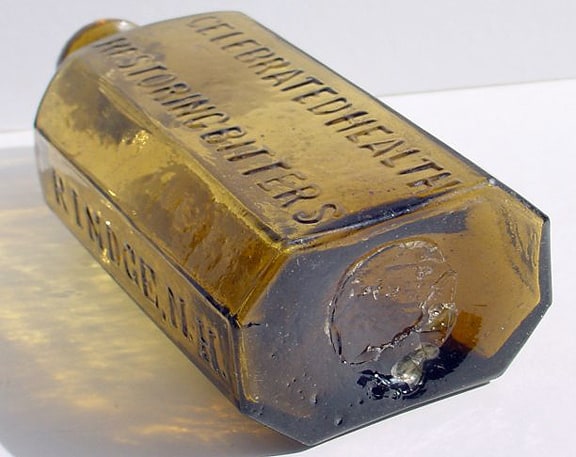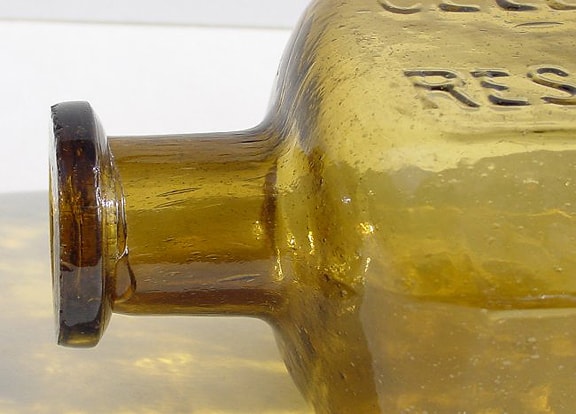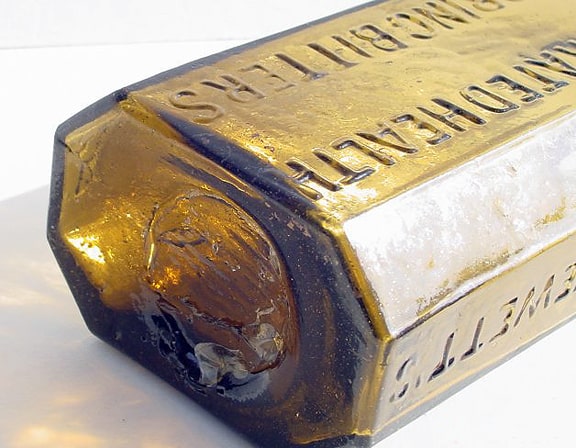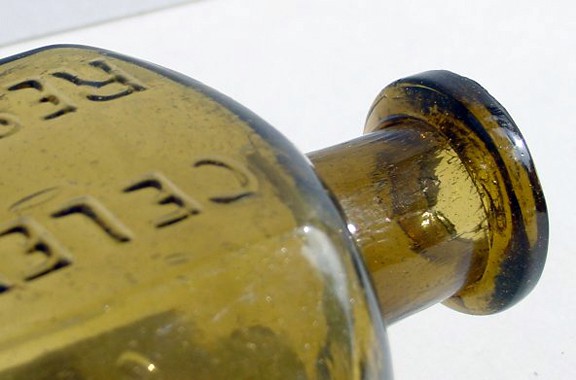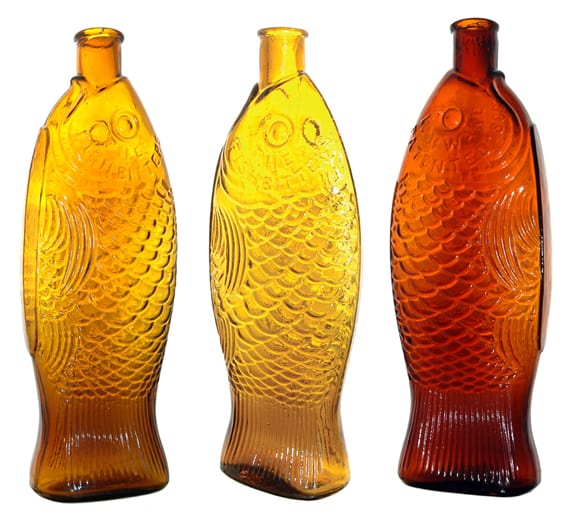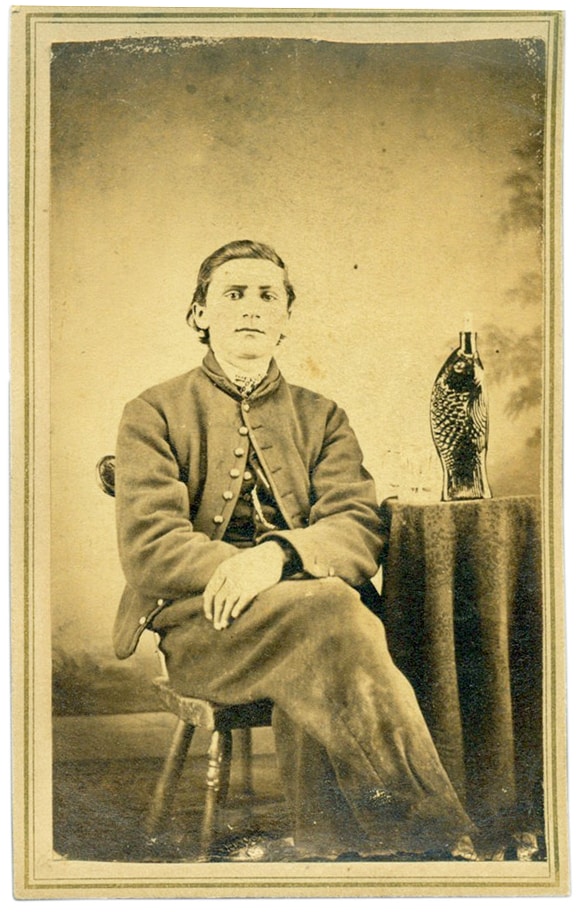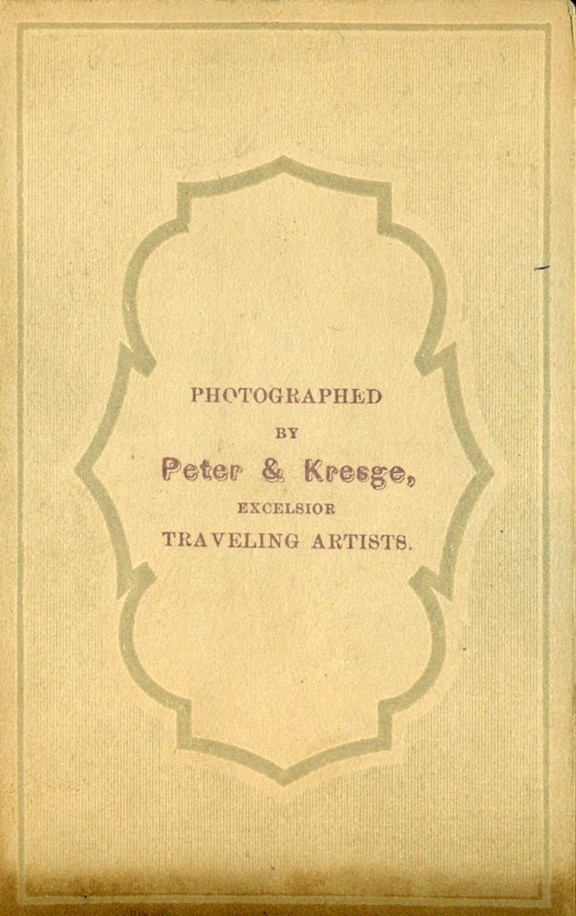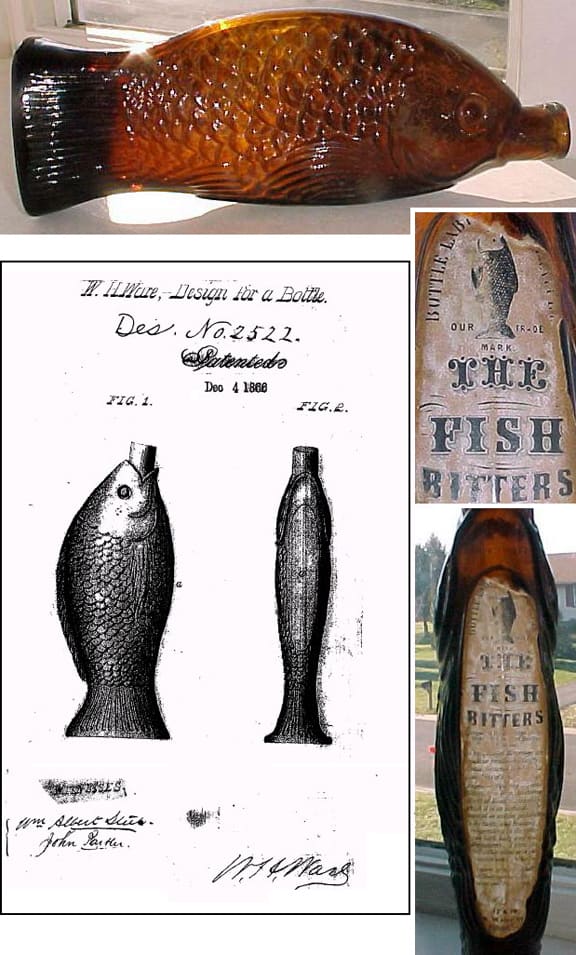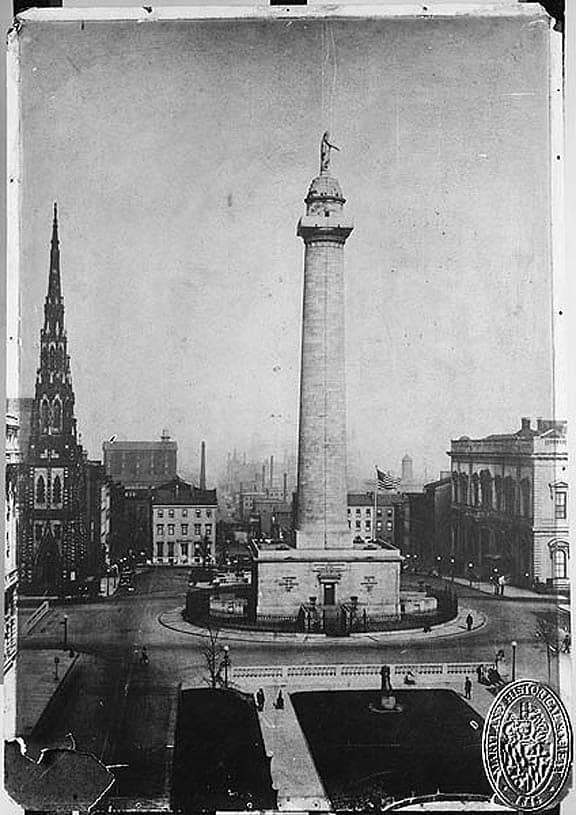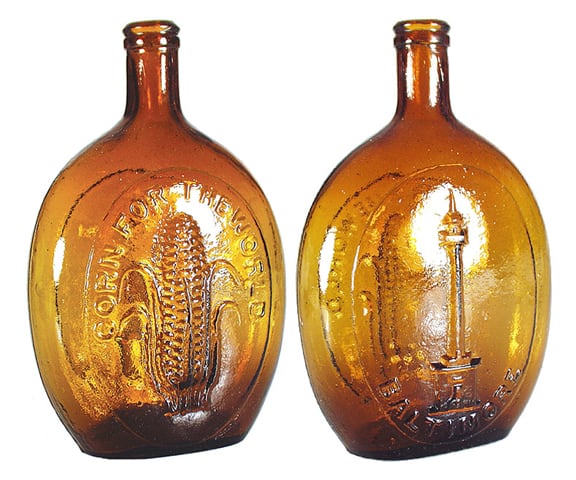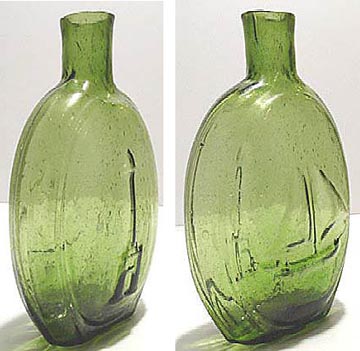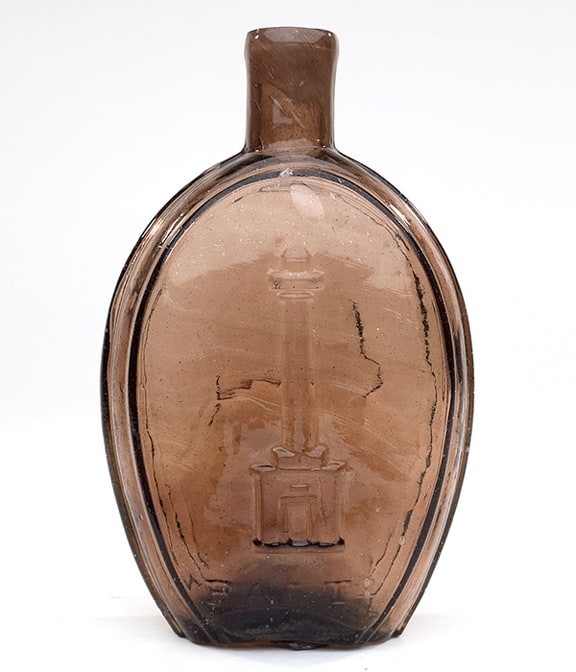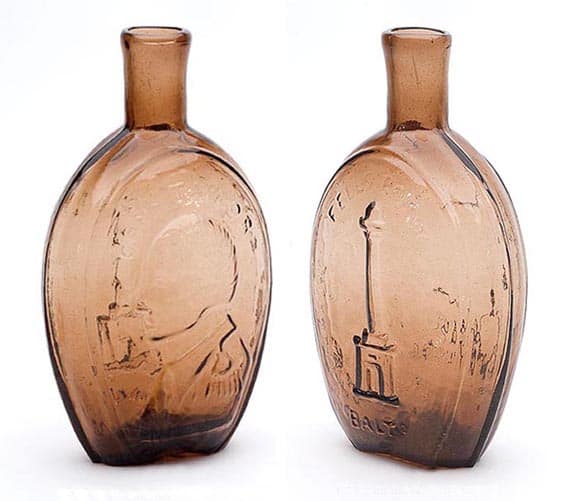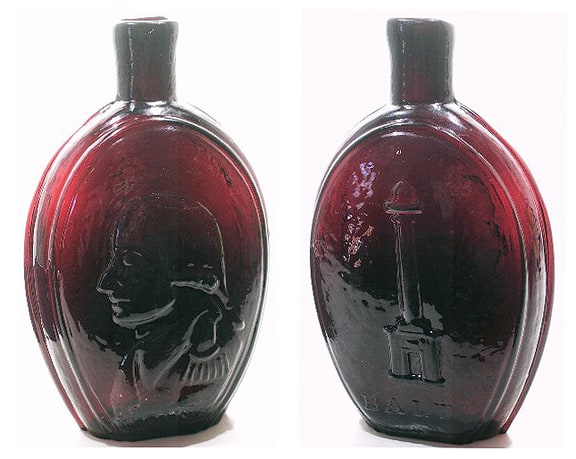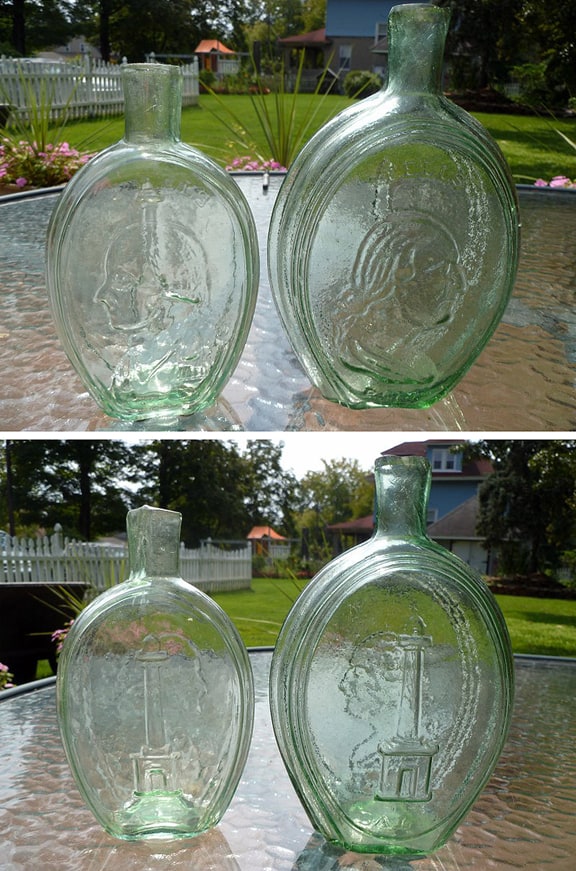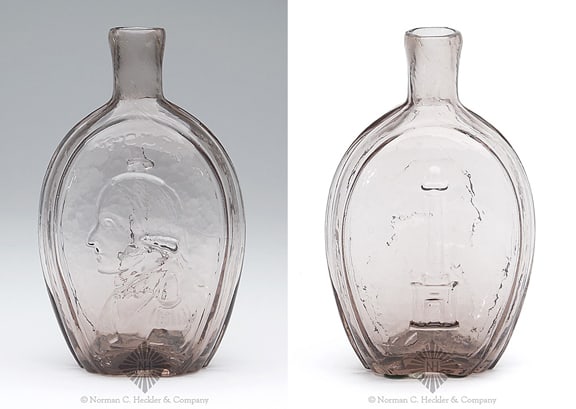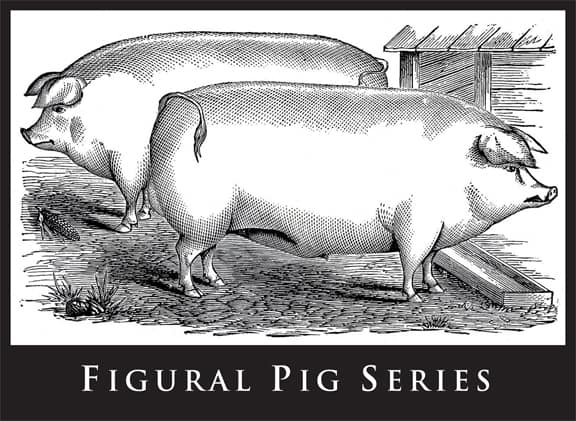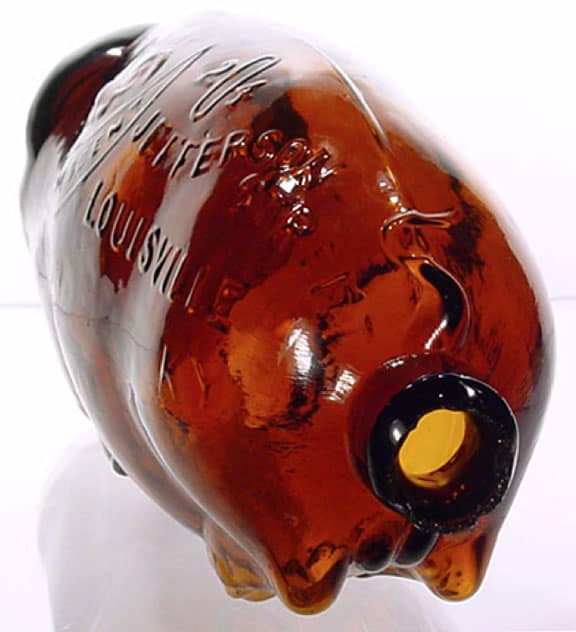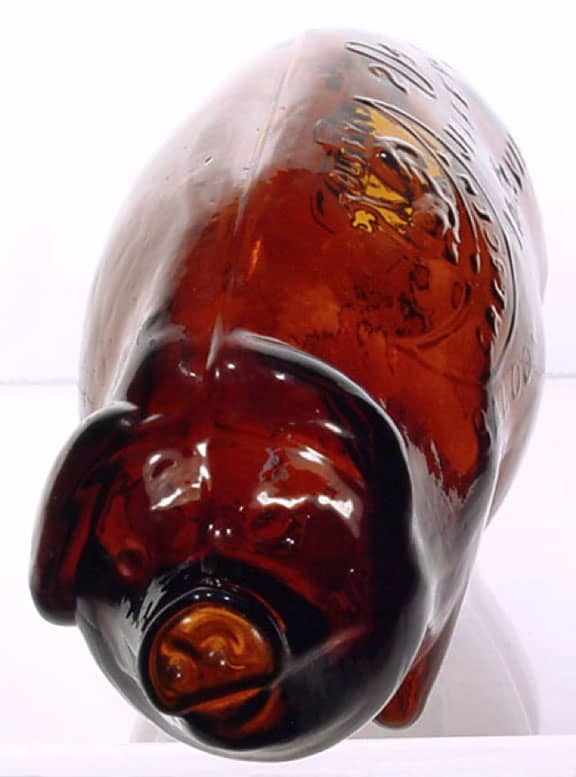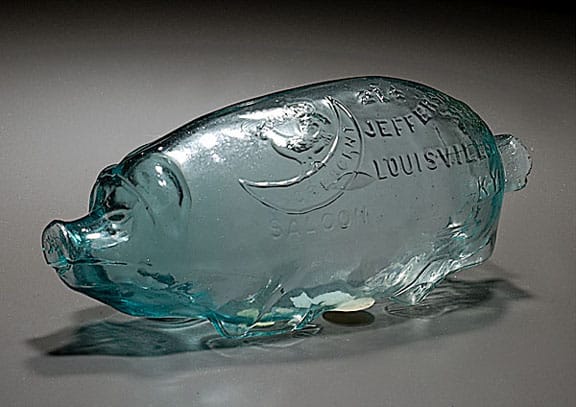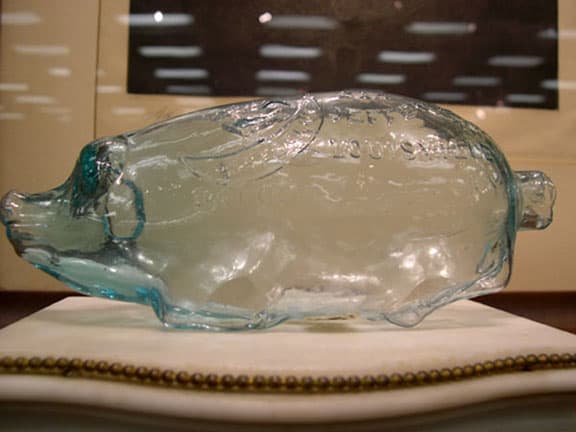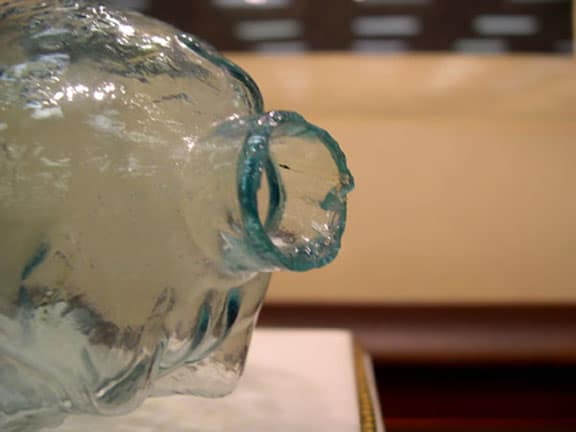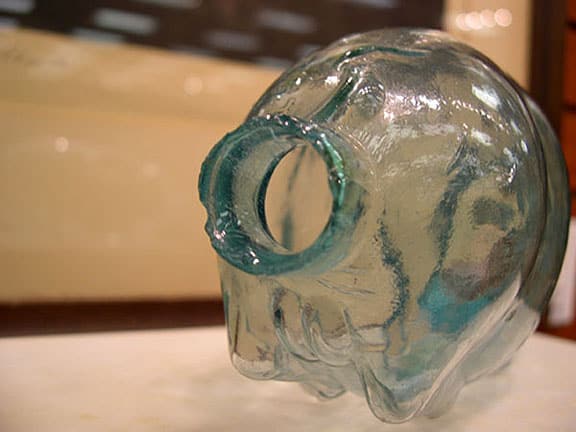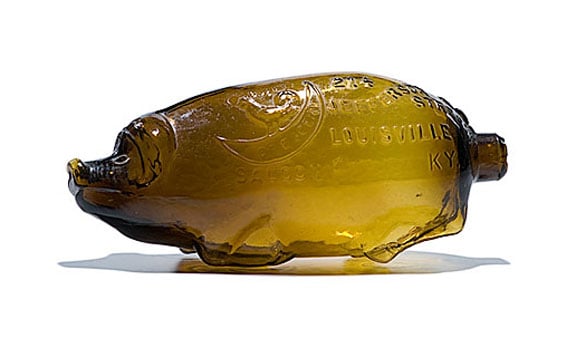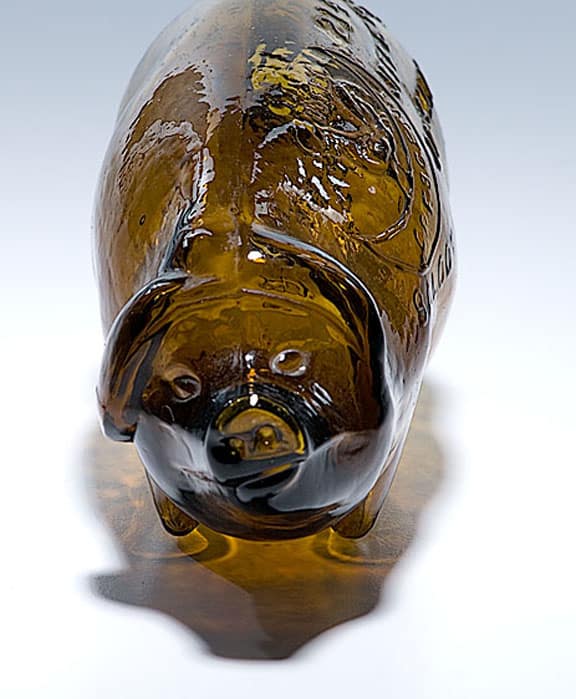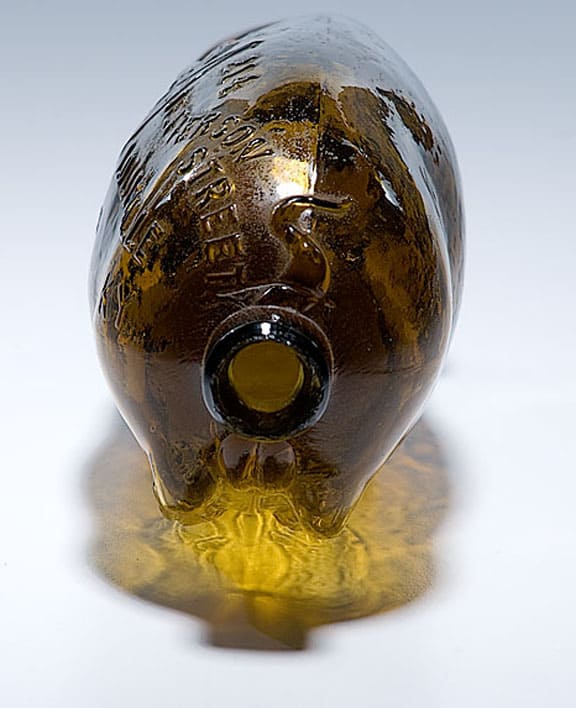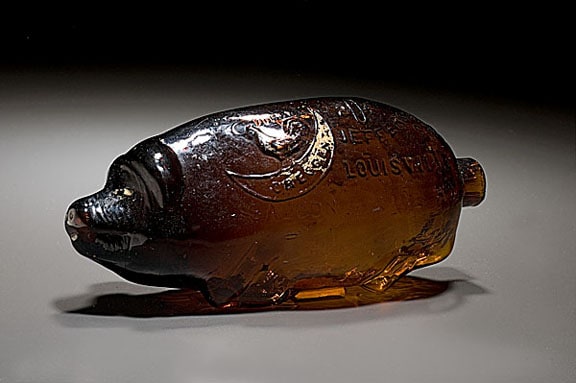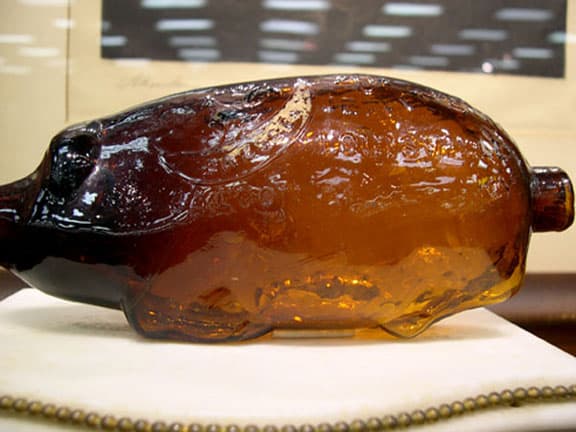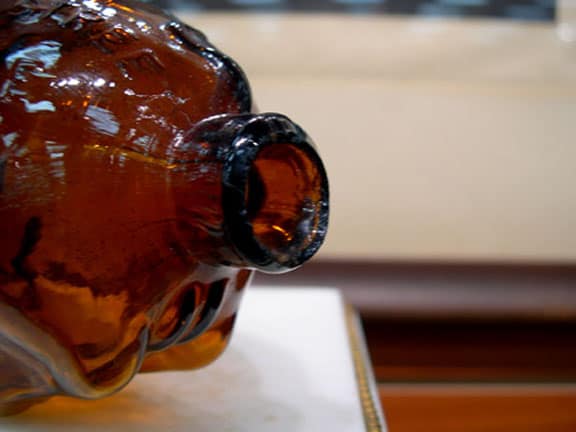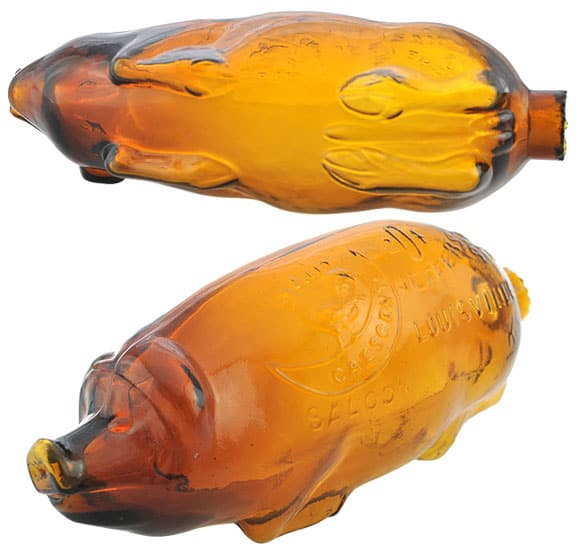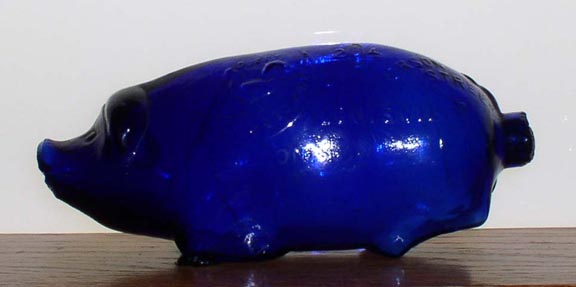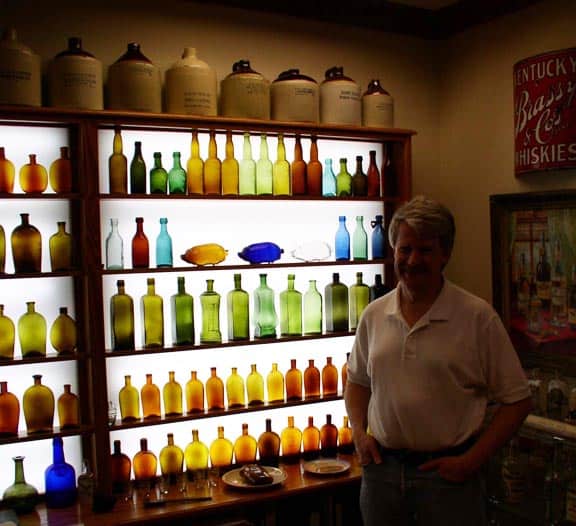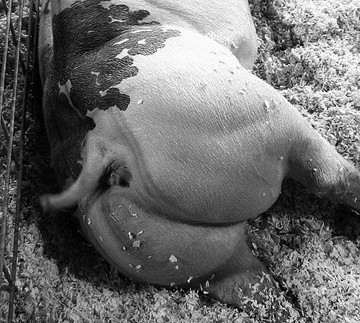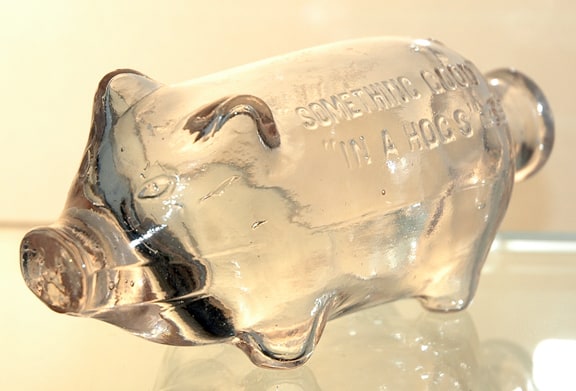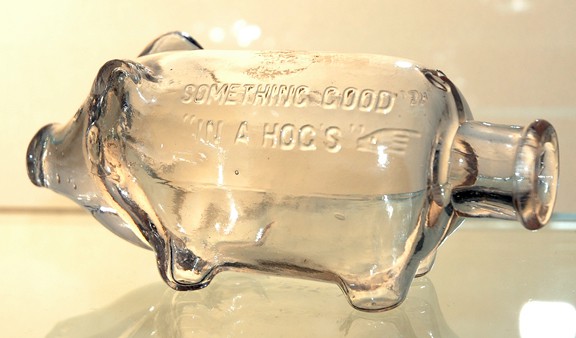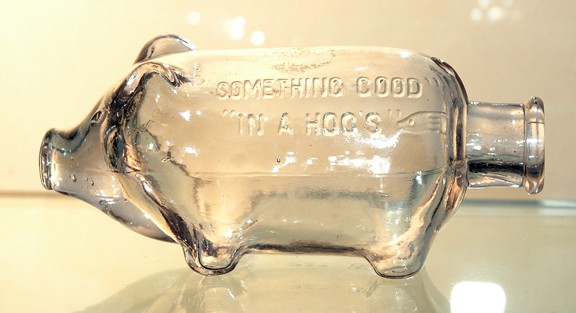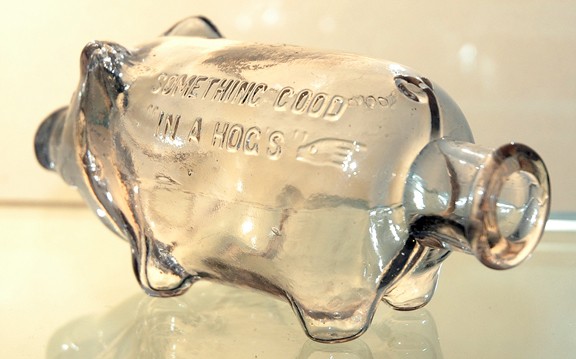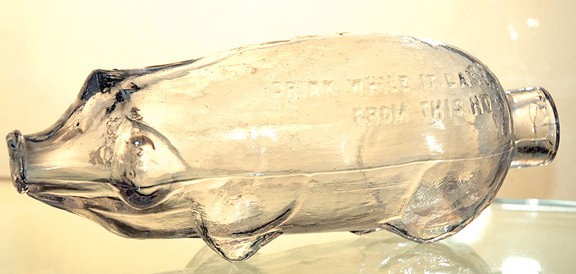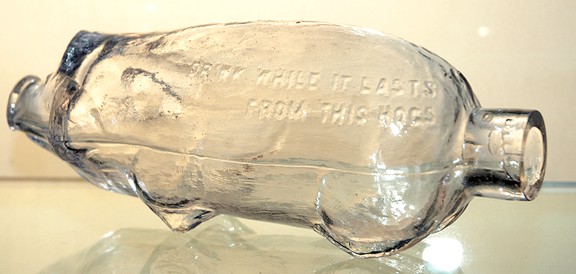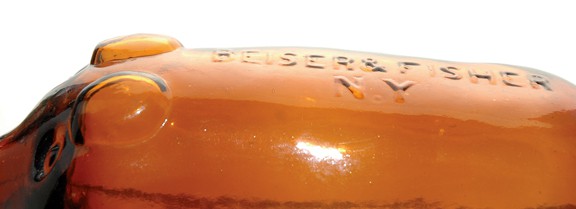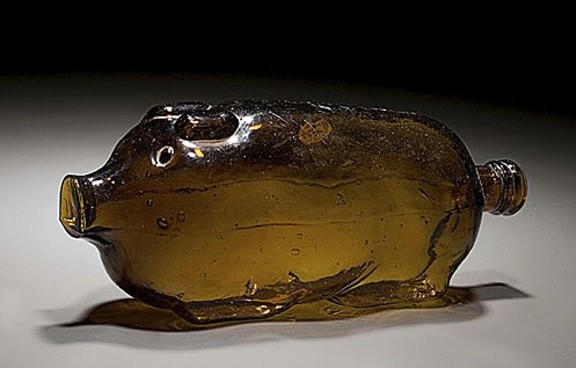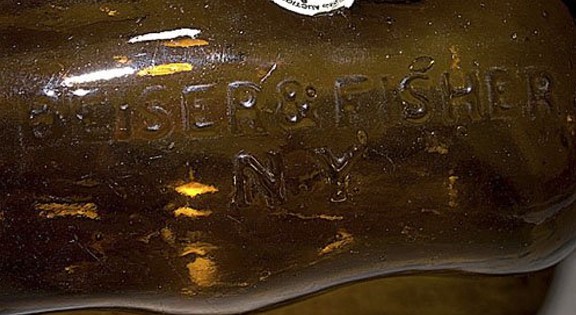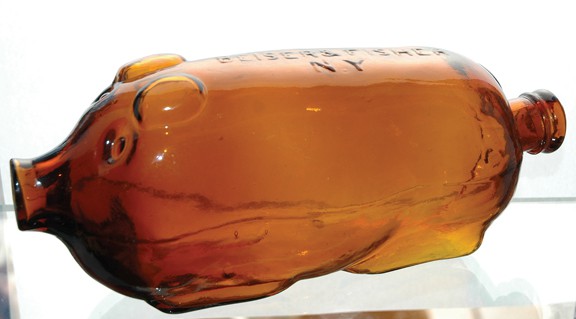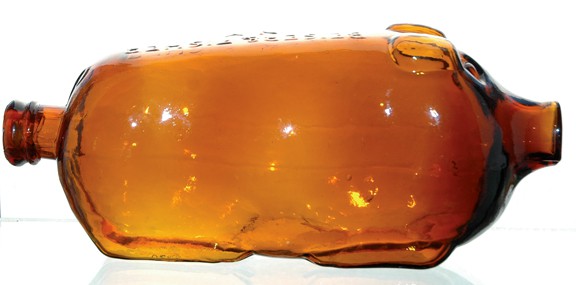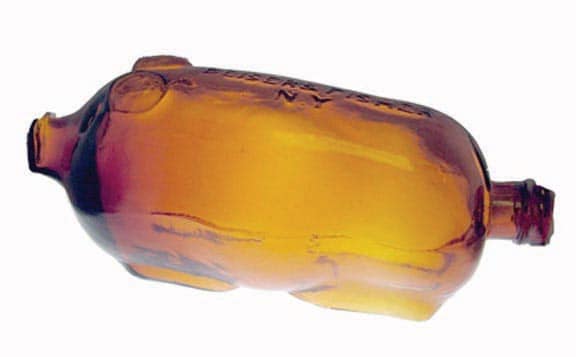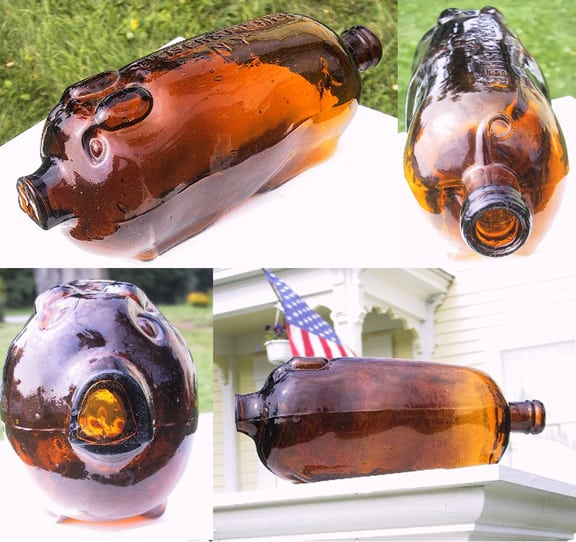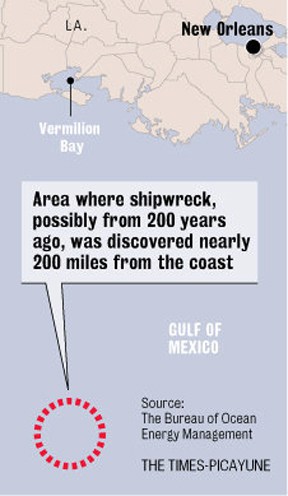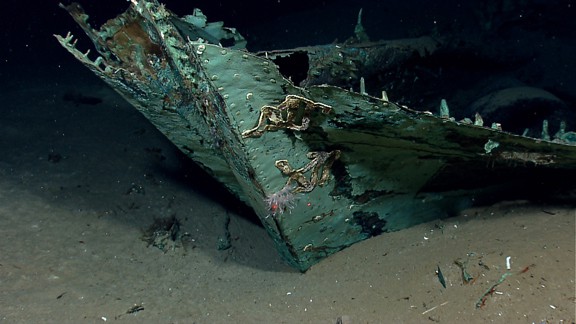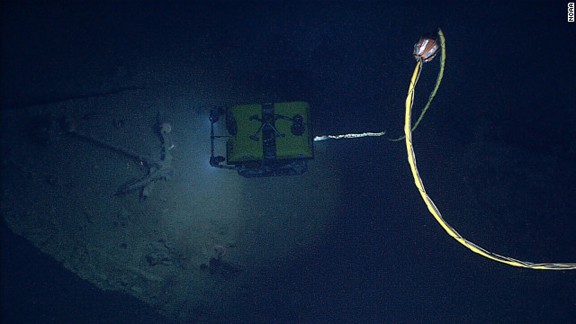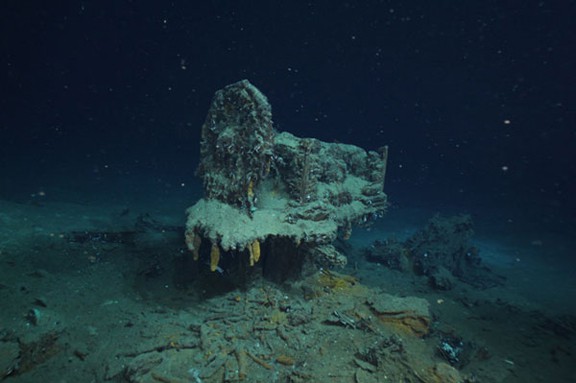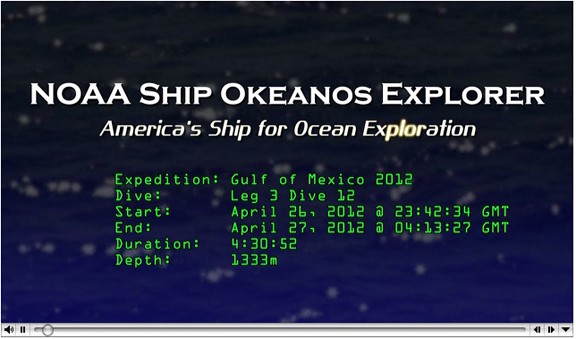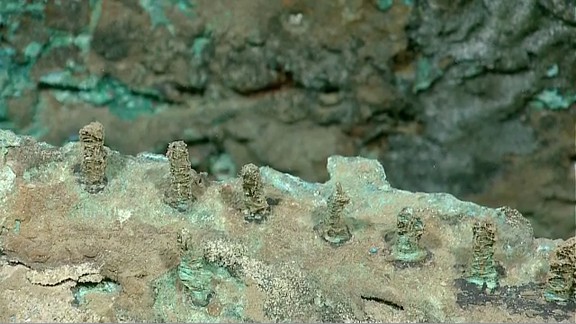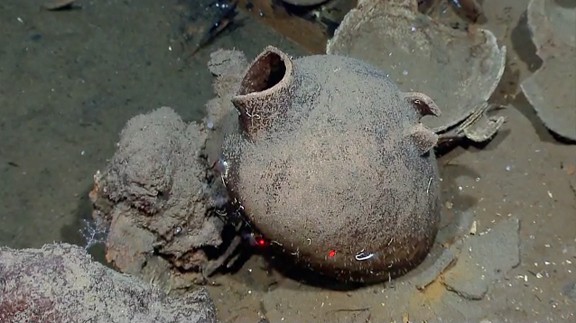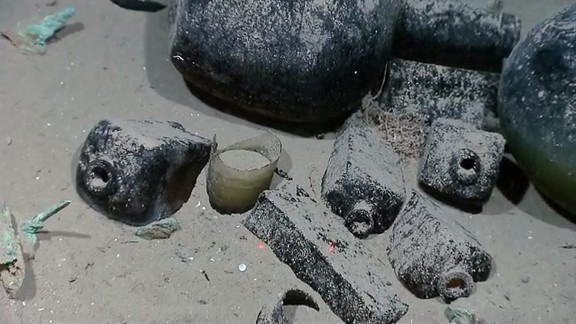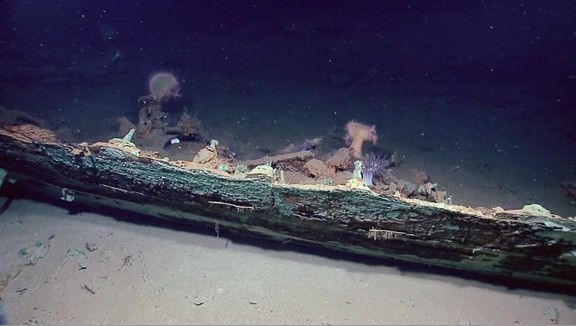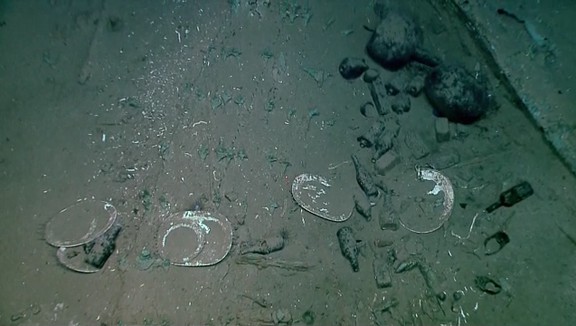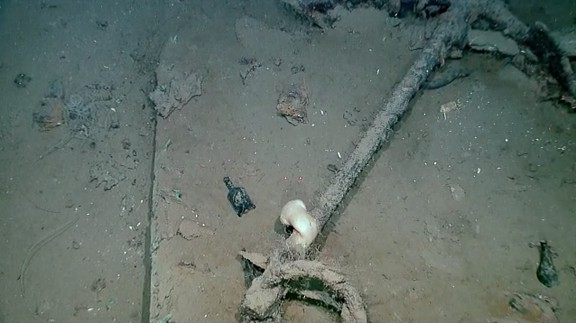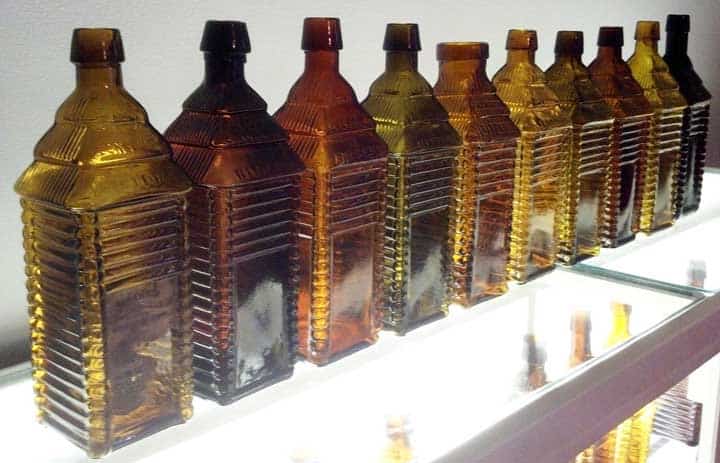
Drake’s Plantation Bitters mold variants (from left to right). D102, D103, D104, D105, D105.5, D106, D108, D108.5, D109, and D110 – Brian Shultis
Information on the Drake’s Plantation Bitters Variants
19 May 2012
Drakes authority Brian Shultis recently commented on facebook:
“There has been a lot of talk about Drake’s mold variants on here. I will post up a few comparison shots for those who don’t already know. Maybe it will interest a few collectors. First comparison is between a D 105 and D 106. Also, I noticed some of the auction houses don’t even list Drake’s by mold variant in their descriptions. Usually it is just listed as a 4, 5 or 6 log Drake’s”.
 This made me want to pull out my Carlyn Ring & W.C. Ham Bitters Bottles and Bitters Bottles Supplement books and look more closely at my bottles, of which I have many as I specialize in color runs. I have listed each Ring & Ham Drake’s variant along with a picture of the bottle, if available, for illustrative purposes.
This made me want to pull out my Carlyn Ring & W.C. Ham Bitters Bottles and Bitters Bottles Supplement books and look more closely at my bottles, of which I have many as I specialize in color runs. I have listed each Ring & Ham Drake’s variant along with a picture of the bottle, if available, for illustrative purposes.
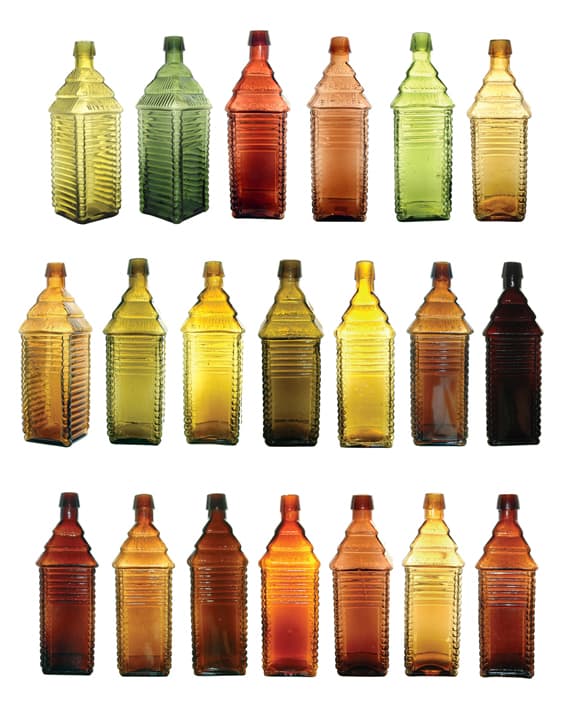
Drakes Plantation Bitters (6 log) – Meyer Collection
Drake’s Plantation Bitters was a very successful brand, probably exceeded only by Dr. Hostetter’s Stomach Bitters. Because of the large number of these bottles that were produced in the 4, 5 and 6 log cabin designs, it is probable that many molds were used. A careful study of the bottles would undoubtedly identify additional molds. The 4 log variant is the oldest bottle. Information listed in Ring and Ham but can not be supported.
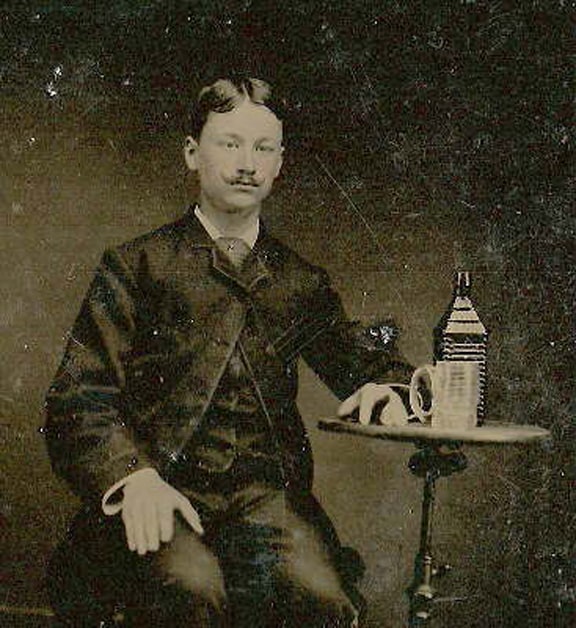
The gentleman pictured in the ca. 1870 tintype above was fond enough of the product to have his picture taken with it!
D 102
D 102 // s // motif arabesque / DRAKES / motif arabesque / PLANTATION / BITTERS enclosed in a rectangle // 3 tiers of thatching // tier of thatching/ PATENTED / 1862 / tier of thatching // 3 tiers of thatching //
10 x 2 7/8 (6)
Square cabin, LTC, Applied mouth, Amber, Puce and Amethyst-Rare;
Green-Extremely rare
17 logs including the base, 6 logs over the label panels
Read more: What is an Arabesque Drakes Plantation Bitters
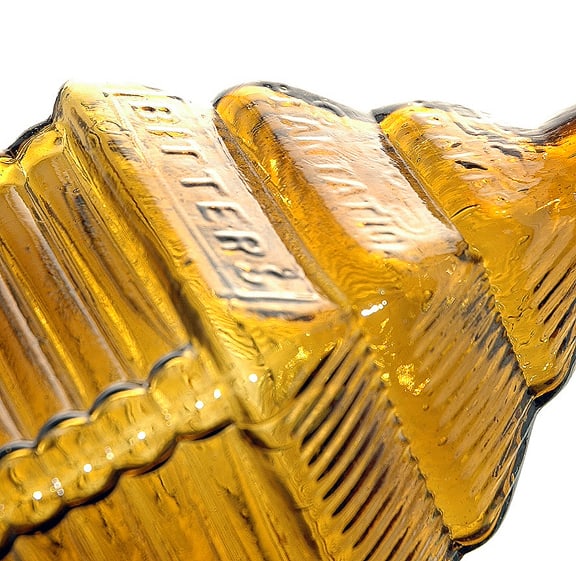
D 102 Arabesque DRAKE’S PLANTATION BITTERS – Meyer Collection
D 103
D 103 // s // S T // DRAKE’S / 1860 / PLANTATION / BITTERS // 3 tiers of thatching // tier of thatching / PATENTED / 1862 / tier of thatching // 3 tiers of thatching //
10 x 2 7/8 (6)
Square cabin, LTC and LTCR, Applied mouth, Amber and Puce – Common;
17 logs including the base, 6 logs over label panels

D 103 DRAKES’S PLANTATION BITTERS – Meyer Colection
D 104
D 104 // s // S T // DRAKE’S / 1860 / PLANTATION / BITTERS // 3 tiers of thatching // tier of thatching / PATENTED / 1862 / tier of thatching // 3 tiers of thatching //
10 x 2 7/8 (6)
Square cabin, Amber, LTC, Applied mouth, Rare
6 logs over label panel on all four sides
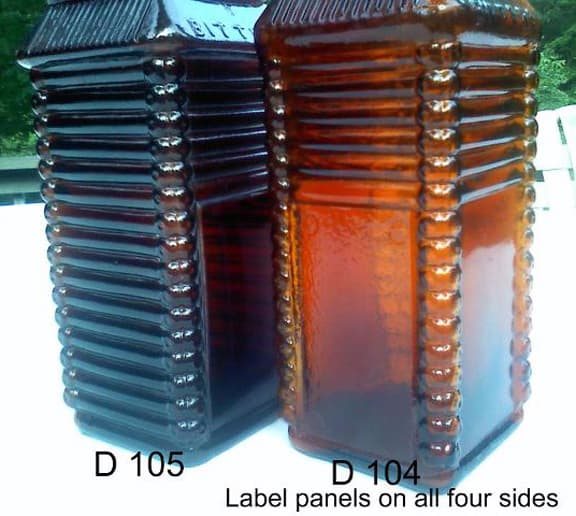
D 104 DRAKE’S PLANTATION BITTERS comparison – Brian Shultis

D 104 DRAKE’S PLANTATION BITTERS label panel – Brian Shultis
D 105
D 105 // s // S T // DRAKE’S / 1860 / PLANTATION / X / BITTERS // 3 tiers of thatching // tier of thatching / PATENTED / 1862 / tier of thatching // 3 tiers of thatching //
10 x 2 7/8 (6)
Square cabin, LTC, Applied mouth, Amber and Puce – Common;
Yellow olive and Green – Rare; Aqua – Extremely rare
17 logs including the base, 6 logs over label panels
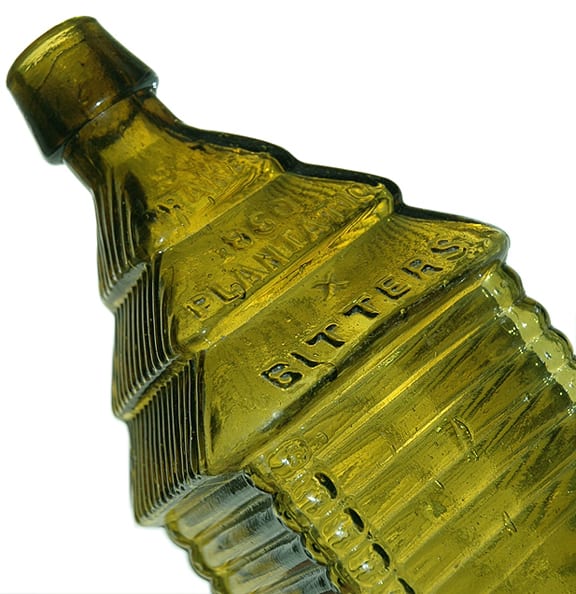
D 105 DRAKE’S PLANTATION BITTERS – Forbes Collection
D 105.5
D 105.5 // s // S T // DRAKE’S / 1860 / PLANTATION / X / BITTERS // 3 tiers of thatching // tier of thatching / PATENTED / 1862 / tier of thatching // 3 tiers of thatching //
10 x 2 7/8 (6)
Square cabin, LTC, Amber, Wide or expanded mouth, Extremely rare
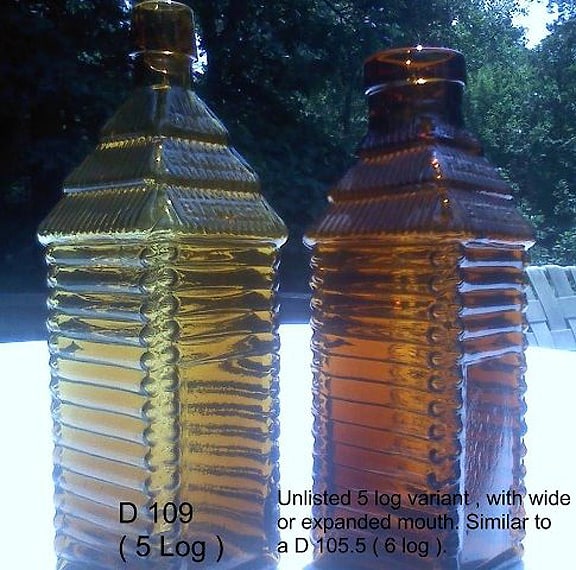
Unlisted 5-log variant (D 109) with wide or expanded mouth similar to a D 105.5. – Brian Shultis
D 106
D 106 // s // S T // DRAKE’S / 1860 / PLANTATION / X / BITTERS // 3 tiers of thatching // tier of thatching / PATENTED / 1862 / tier of thatching // 3 tiers of thatching //
10 x 2 7/8 (6)
Square cabin, LTC and LTCR, Applied mouth, Amber and Puce – Common;
Green – Very rare
17 logs including the base, 6 logs over label panels
Variation in the word Bitters with smaller letters and off center placement, Variation with line under Bitters
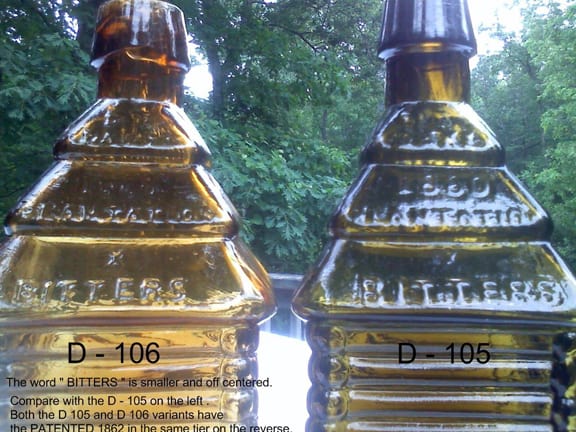
DRAKES D 106 & D 105 comparison – Brian Shultis
D 106.5
D 106.5 // s // S T // DRAKE’S / 1860 / PLANTATION / X / BITTERS // 3 tiers of thatching // tier of thatching / PATENTED / 1862 / tier of thatching // 3 tiers of thatching //
10 1/4 x 2 7/8 (6)
Square cabin, LTC, Applied mouth, Amber, Very rare
17 logs including the base, a vertical log one log high at each corner of base, 6 logs over label panels. There are two tiers of thatching on reverse. Embossing is larger and more bold than on the previous bottles. The log pattern around the base and corners are indented and distinctly rounded. Thatching and log pattern are very bold, and the 1860, X, and BITTERS embossing is larger and very bold.
D 107
D 107 // s // S T // DRAKE’S / 1860 / PLANTATION / X / BITTERS // 3 tiers of thatching // tier of thatching / PATENTED / 1862 / tier of thatching // 3 tiers of thatching //
10 x 3 3/4 (6 1/4)
Square cabin expanded to become bulbous, Amber, LTC, Rough pontil mark
Extremely rare
One known example which is believe to be unique
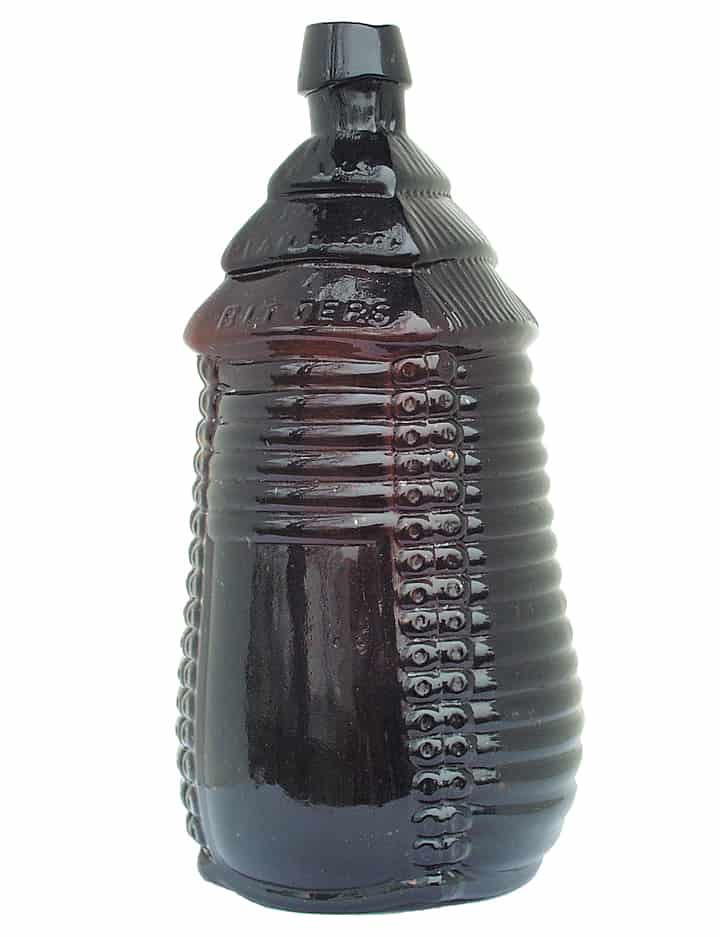
The unique and bulbous D 107 DRAKE’S PLANTATION BITTERS as pictured in Bitters Bottles Supplement
D 107.5
D 107.5 // s // S. T. // DRAKE’S / 1860 in thatching / PLANTATION in thatching / BITTERS in thatching // 3 tiers of thatching // tier of thatching / PATENTED / tier of thatching interrupted by 1869 raised and interrupting thatching / 3 tiers of thatching //
10 x 2 7/8 (6)
Square Amber, LTC, Applied mouth, Scarce
17 logs including the base, 6 logs over label panels
Roof embossing like D 108, roof configuration and base like D 105
D 108
D 108 // s // S T // DRAKE’S / 1860 / PLANTATION / X / BITTERS // 3 tiers of thatching // tier of thatching / PATENTED / 1862 raised and interrupting thatching / 3 tiers of thatching //
10 x 2 7/8 (6)
Square cabin, LTC, Applied mouth, Amber and Puce – Common;
Green – Very rare
17 logs including the base, 6 logs over label panels.
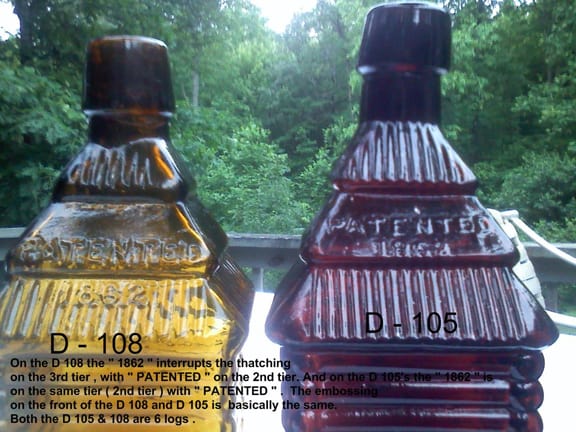
DRAKES D 108 & D 106 comparison – Brian Shultis
D 108.5
D 108.5 // s // S T // DRAKE’S / 1860 / PLANTATION / X / BITTERS // 3 tiers of thatching // tier of thatching / PATENTED / 1862 raised and interrupting thatching / 3 tiers of thatching //
9 7/8 x 2 7/8 (6)
Square cabin, LTC, Applied mouth, Amber, Extremely rare
17 logs including the base, 6 logs over label panels, base corners are chamfered on the bottom log.

Base on a D 108.5 Drake’s (chamfered base corners). Apparently two known examples – photo Brian Shultis
D 109
D 109 // s // DRAKES in thatching / PLANTATION in thatching / BITTERS in thatching // 3 tiers of thatching // tier of thatching / PATENTED / 1869 / tier of thatching // 3 tiers of thatching //
10 x 2 7/8 (6)
Square, LTC and LTCR, Applied mouth
Amber and puce, Scarce, Green – Extremely rare
15 logs including the base, 5 logs over label panels
Date of reverse usually misread as 1862
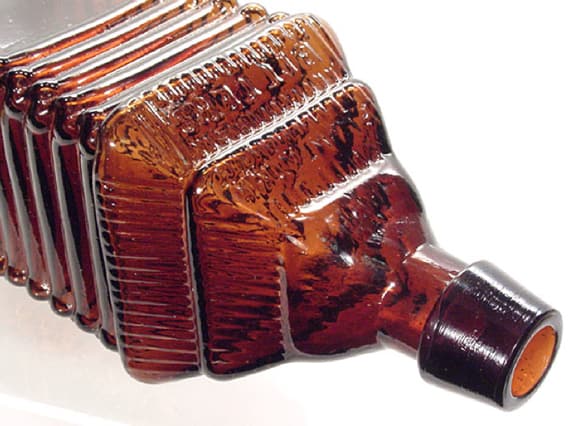
D 109 DRAKE’S PLANTATION BITTERS (5 log variant) – GreatAntiqueBottles.com
D 110
D 110 // s // S T // DRAKE’S / 1860 / PLANTATION / BITTERS // 3 tiers of thatching // tier of thatching / PATENTED / 1862 interrupting thatching / 3 tiers of thatching
10 1/4 x 2 5/8 (6)
Square cabin, LTC, Applied mouth and Tooled lip;
Amber, Common; Yellow, Scarce; Yellow olive, Scarce
15 logs including the base, 4 logs over label panels
Tooled lip example known with 1898 date on label
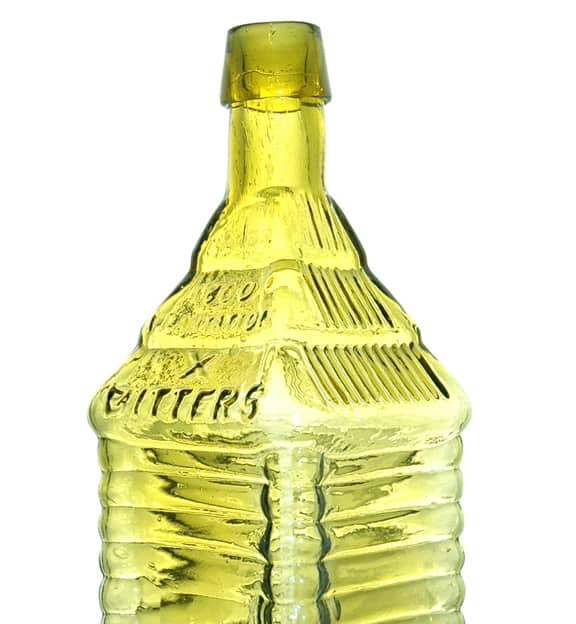
D 110 DRAKE’S PLANTATION BITTERS (4-Log variant, thin and tall neck) – Meyer Collection


